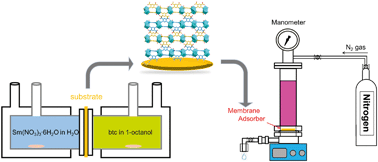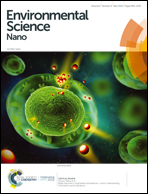Membrane adsorber containing a new Sm(iii)–organic framework for dye removal†
Abstract
An expanding textile industry has exacerbated the problem of dealing with effluent that contains dye molecules. Despite the development of techniques for recycling or decomposing dyes in wastewater, researchers have yet to develop a highly efficient method for the recovery of dye molecules from textile effluent. Herein, we propose a novel approach to the capture of dye molecules using an inexpensive membrane adsorber. As proof-of-concept, we synthesized a new metal–organic framework (MOF) comprising [Sm2(btc)(H2btc)(H2O)4]·4H2O (SmBTC; btc = 1,2,4,5-benzenetetracarboxylic acid). The synthesis of SmBTC was conducted in the aqueous phase to reduce the need for organic solvents. Compared to existing MOFs, SmBTC had a high adsorption capacity for Rose Bengal (380 mg g−1). Membranes containing SmBTC crystals were prepared by interfacial growth using various inexpensive polymeric substrates. The results indicate that the chemical properties of the substrate affect the distribution of SmBTC crystals in the membrane. A uniform distribution of SmBTC crystals in the membrane was found to be critical for the efficient removal of Rose Bengal from aqueous solutions. The membrane adsorber prepared in this work showed a high adsorption capacity as well as a high water permeance (4330 L m−2 per bar per h) for the removal of Rose Bengal from aqueous solutions.

- This article is part of the themed collection: Nanomaterial applications in water


 Please wait while we load your content...
Please wait while we load your content...